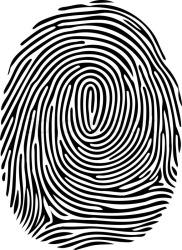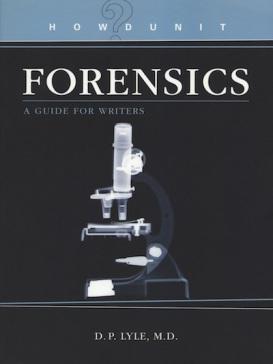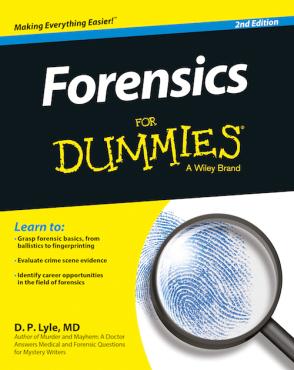
LISTEN: https://soundcloud.com/authorsontheair/criminal-mischief-episode-30-evidence
PAST SHOWS: http://www.dplylemd.com/criminal-mischief.html
SHOW NOTES:
From HOWDUNNIT: FORENSICSIf Locard's Exchange Principle is the cornerstone of forensic science, evidence is the heart and soul of the crime lab. Indeed, evidence is the sole reason it exists. Without evidence, what would the lab do? Evidence is used to determine if a crime has been committed, to link a suspect to a scene, to corroborate or refute an alibi or statement, to identify a perpetrator or victim, to exonerate the innocent, to induce a confession, and to direct further investigation.
The modern crime lab attempts to identify and compare any evidence it receives and then links this evidence to a particular individual to the exclusion of all others.
This brings up a critical concept: Evidence is used to eliminate suspects rather than to point the finger at any one person. Individualizing evidence eliminates everyone else and leaves the perpetrator standing alone.
This isn't a modern concept. Again, we look to Sherlock Holmes, who discusses in several of his stories his belief that good evidence and clear reasoning would eliminate all choices but one. My favorite comes from "The Adventure of the Beryl Coronet" in which he states, "It is an old maxim of mine that when you have excluded the impossible, whatever remains, however improbable, must be the truth."
DIRECT AND CIRCUMSTANTIAL EVIDENCEEvidence may be either direct or circumstantial. Direct evidence directly establishes a fact. Examples are eyewitness statements and confessions, which are subjective by nature and, as such, are burdened with the problems that plague all subjective information. Eyewitnesses are notoriously incorrect in their identification of a suspect and their recall of events because memory and recall are affected by the witnesses' mental and physical health and abilities, prejudices, experiences, and the emotion of the situation. What if the witness had poor vision or poor hearing, or held racial prejudices, or was highly emotional? Could his perception of who did what to whom, when, and how be distorted? Absolutely. Though most often these distortions are not intentional, they exist nonetheless. Studies of this phenomenon have shown that eyewitnesses may be wrong as much as 50 percent of the time.
On the other hand, circumstantial evidence is more objective and is subject to the laws of probability. This leads to the curious fact that circumstantial evidence is often more reliable than direct evidence. Unlike an eyewitness account, accurate science is not altered by subjectivity. Its interpretation might be, but the result is the result.
Circumstantial evidence is any evidence that is not direct. Blood, hair, fibers, bullets, DNA-indeed, all forensic science evidence-are circumstantial in nature. This type of evidence requires that the judge and jury infer something from the presented evidentiary fact. For example, if a fingerprint or hair found at the crime scene is matched to a suspect, the jury may infer that the print is that of the defendant and the fact that it was found at the crime scene links the defendant to the scene. Under most circumstances, this is not absolute proof, but is highly suggestive that he was involved in the crime.
IDENTIFICATION AND COMPARISONThe forensic analysis of evidence items is done for two main purposes: identification and comparison. Identification is done to determine what exactly a particular item or substance is. Is this white powder heroin or crystal methamphetamine or sugar? Who manufactured the shoe that left the print at the crime scene? Are there petrochemical residues present in the debris of a suspicious fire? Is this brown carpet stain dried blood or chocolate sauce?
Identification in such circumstances is critical since, if the powder is sugar and not heroin or the stain is indeed chocolate sauce and not blood, there might be no crime at all. Conversely, if heroin or blood is identified, either may become the crucial evidence in a criminal proceeding. Such identifications make up an important part of the work done by the crime lab. After testing, the examiner may state that the questioned substance is present, not present, or that the testing is inconclusive and the presence of the substance can be neither ruled in nor out.
Comparisons are done to see if a suspect item or substance shares a common origin with a known one. That is, did they come from the same person, place, or object? Did this fingerprint, hair, or blood come from the suspect? Does this paint smudge found on a hit-and-run victim's clothing match that of the suspect's car? Does the bullet removed from a murder victim match the one test-fired from the suspect's gun?
For example, after comparing a crime scene fingerprint to one obtained from a suspect, the examiner may state that the two match (bad news for the suspect), do not match (may exonerate the suspect), or that the comparison was inconclusive, perhaps because the crime scene print was of poor quality. In the last case, the suspect is neither cleared nor condemned.
CLASS VS. INDIVIDUAL CHARACTERISTICSSome types of evidence carry more weight than others. Hair and fibers can suggest, while DNA and fingerprints can absolutely make a connection. The difference is that some evidence shares class characteristics and others individual characteristics.
Class characteristics are those that are not unique to a particular object, but rather serve to place the particular bit of evidence into a specific class. For ex- ample, if a victim has been shot, the determination that the bullet was from a
.38 caliber handgun would make all .38 caliber handguns the possible murder weapon. Other calibers would not belong to this class and would be excluded from consideration. Alternatively, blood recovered from a crime scene could be found to be type B. It could have come from any of the tens of millions of people who share this blood type. If the suspect has type B blood, he remains a suspect and DNA testing will be required to conclusively match the sample to the suspect. But if he has type A blood, he is excluded.
A single piece of class evidence can rarely convict, but it can often exonerate. The above type B blood would exclude all persons with a different blood type. They belong to a different class and only those in the class of individuals with type B blood would remain in the suspect pool. However, if multiple types of class evidence are associated with one suspect, the weight of the evidence may make a strong case. A classic example is the Atlanta child murders case.
In cases such as this, the sheer number of the pieces of class evidence makes coincidence extremely unlikely. What are the odds that someone else left behind this combination of fibers and hair? Though class evidence is not absolute proof that a suspect is connected to a particular location, and each bit of class evidence taken alone may not be strong, when a large number of matching evidence is found, the odds that the suspect was present at the crime scene becomes overwhelming.
Individual characteristics are as close to absolute proof of the origin of the evidence item as is possible. The most individualizing types of evidence are finger- prints and DNA, since no two people possess either the same prints or the same DNA (the exception being identical twins who have the same DNA but different fingerprints).
Impression evidence, such as bullet ballistic markings, shoe and tire tracks, and tool marks, may be unique enough to be considered individual evidence. Also, fracture or tear patterns, such as in broken glass, torn paper, or matches ripped from a matchbook, may possess edges that fit perfectly together like a jigsaw puzzle, thus indicating the pieces shared a common source.
The overriding principle in the analysis of individual characteristics is that no two things are exactly alike. No two guns mark a bullet the same way. No two pieces of glass fracture in the same manner. No two pairs of shoes or sets of car tires wear in exactly the same way.
The goal of the criminalist is to identify individualizing characteristics, for these truly "make the case" by positively identifying the source of the questioned evidence. If ballistics matched the markings on a .38 caliber bullet to those from a bullet test-fired by a suspect weapon, these markings are individual evidence. They separate this particular gun from all other .38 caliber weapons and indicate that this particular .38 was the murder weapon. Similarly, in the earlier type B blood example we just discussed, DNA could be used to eliminate all of the people with type B blood except for the one person who actually left the blood at the crime scene.
The bottom line is that class evidence can considerably narrow the field of suspects and individual evidence can narrow it further, perhaps to a single person.
RECONSTRUCTIVE AND ASSOCIATIVE EVIDENCEWhether the evidence is class or individual in quality, it may be used to reconstruct the events of the crime or to associate a suspect with the crime scene.
Reconstructive evidence is any evidence that helps in reconstructing the crime scene. Broken glass or pried doors and windows may reveal the perpetrator's points of entry and exit. Was the window broken from the inside or the outside? Did the perpetrator use a key or a screwdriver to gain entry? Shoe prints, blood spatters, and the trajectory of bullets may show where in the room everyone was and exactly how and in what sequence the crime occurred. Was the victim attacked from the front or from behind? Was the murder quick or did a struggle occur? Was the prime suspect at the scene at the time of the murder or did he, as he says, stumble into the scene later?
Reconstructive evidence helps the ME determine who did what, where, when, and how, as well as helps determine who is being truthful and who might be lying. Crime scene reconstruction is discussed in greater detail later in the chapter.
Associative evidence is evidence that ties the suspect to the crime scene. Fingerprints, shoe prints, hair, fibers, blood and other body fluids, knives, bullets, guns, and paint, among others, may be used to link the suspect to the scene, or prove that the fingerprints, hair, or blood is not his and that someone else must have committed the crime.
This linkage was discussed in Chapter One, but is worth a brief mention here. Evidence is supposed to link a suspect to a person, place, or object. The finding of a victim's hair or fibers from the victim's clothing on the clothing of the suspect suggests that they had some degree of contact, and thus links the two together. A suspect's fingerprint, blood, or semen at the scene of a robbery, murder, or rape strongly links him to the crime scene. A murder weapon that holds a suspect's fingerprints requires a great deal of explaining. Each of these circumstances links elements of the crime to the suspect. The link can be established through the criminalists collecting evidence and the analytical procedures of the crime lab work. When successful, the evidence may find its way into court and result in a conviction.
To dig deeper into this subject grab a copy of either:

HOWDUNNIT: FORENSICS: http://www.dplylemd.com/book-details/howdunnit-forensics.html

FORENSICS FOR DUMMIES: http://www.dplylemd.com/book-details/forensics-for-dummies.html
